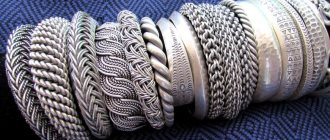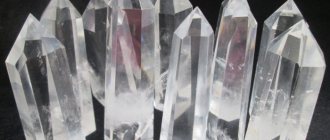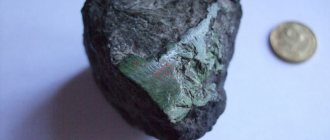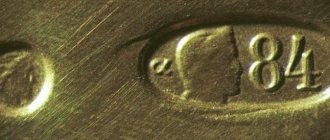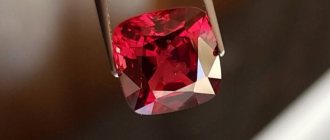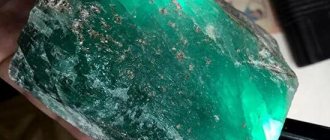A rich blue hue, golden inclusions, magical and healing properties, an ancient history dating back thousands of years - all this can rightfully be said about the mineral whose name is lapis lazuli stone.
The ancients said that he is the starry sky that fell to Earth. The analogy can be read especially in cases where veins of white marble are observed in the stone.
The history of origin goes back to antiquity. Many legends and beliefs have survived to this day.
Today, everyone can afford jewelry made from semi-precious stone, but in ancient times it was considered precious and was intended only for emperors and nobility.
In this review, we will consider what lapis lazuli is, what its properties are, its meaning, where such an amazing shade came from, what zodiac signs it suits.
What is this stone?
Lapis lazuli belongs to the semi-precious stones of the first order. It is valued for its decorative qualities: its unusual rich blue tone, golden inclusions add originality and effectiveness; one cannot help but feel the special power and magic of the stone.
This is not a gem. It is found in veins or as inclusions in other rocks, in most cases in granite. It is very rare to find lapis lazuli in the form of small crystals.
In addition to the well-known name “Lapis lazuli,” there are several more:
- Azure Stone;
- Lapis - azure;
- Lazurik;
- Bukhara;
- Heavenly;
- Lajvard;
The stone has been called lapis lazuli only since the 18th century, and before that it was more often called lapis - lazuli (it is the most expensive). Translated from Persian, azure means “blue”, so in the Middle Ages it was more often referred to as “azure stone”.
From Moses to Russian emperors
- According to biblical legend, Moses carved God's covenants on lapis lazuli plates and tablets.
- The Supreme Judge of Egypt wore a lapis lazuli figurine of the Egyptian goddess Maat on his chest.
- Theophrastus, in his treatise “On Stones,” described in detail lapis lazuli, turquoise, and carnelian, especially beloved by the Greeks.
- Badakhshan lapis lazuli was worth its weight in silver. And no wonder - the beauty of the violet-blue stone with sparkles of pyrite is mesmerizing. The deposit in Badakhshan has been known since the 3rd millennium BC. From here the stone was exported to India, Mesopotamia and Egypt since ancient times.
- Russian tsars and queens knew how to appreciate beauty. The Winter Palace and the Peterhof Palace are decorated with lapis lazuli. Although this is not the best decoration. The stone itself is good, but the cloudy atmosphere of Northern Palmyra hides the brightness and cheerful shine of the gem.
origin of name
- Lapis lazuli is also often referred to as the rock containing it. However, in foreign gemology the names lapis lazuli and trade names are accepted for it: azur (azure in French), azul (blue in Arabic), matrix lapis .
- Biruni calls the mineral lazavard .
- In Russia, the gem was called lapis lazuli .
Origin story
Initially, the lapis lazuli stone was discovered completely by accident. In ancient times, marble was actively mined, which was used for the construction and interior decoration of palaces and the decoration of statues.
On the border of Afghanistan and Tajikistan, work was underway to extract marble. In an area called Badakhshan, veins of an amazing blue hue were discovered in blocks of marble.
Until now, this deposit is considered one of the most inaccessible for the extraction of lapis lazuli, but over time, other sources were found, including in Russia.
But then, in ancient times, the find was very striking with its extraordinary color, so the emirs proclaimed it the most valuable nugget. By the way, the brightest and most spectacular specimens are still mined in Afghanistan.
Slaves mining the rocks were chained in the mines so that they would not be able to take out even a small amount of - not marble, but lapis lazuli! The appearance of the azure stone was considered a gift from Heaven to the East, and people began to revere it as a symbol of the supreme deity Tengri - Heaven.
Over time, the amazing bright mineral gained unprecedented fame and popularity, was initially used by the Persians, and then came to Egypt. Having conquered Ancient Rome and Ancient Greece, lapis lazuli came to European countries.
On the territory of Russia, the blue tit was mentioned for the first time during the reign of Ivan the Terrible. The blue stone in our stones was also called “lapis lazuli.”
At first it was perceived as an exotic curiosity that came from Rome, Byzantium and other countries, and then deposits of lapis lazuli were found here.
Lapis lazuli in the Catherine Palace
Catherine II made a huge contribution to the production. Over time, the stone was widely used for decoration. For example, the columns of St. Isaac's Cathedral in St. Petersburg are lined with it.
Lapis lazuli was used to decorate the hall in the Catherine Palace (Tsarskoye Selo).
Historical reference
Once upon a time in the East, where Afghanistan borders on Tajikistan, ancient people mined marble, which was the main material for the construction of ancient temples and palaces. It was there, in an area called Badakhshan, that workers discovered bright blue inclusions of lapis lazuli in marble blocks.
The emirs of that area declared the nugget to be of rare value. The slaves who mined the stone were chained to the walls of the mines in order to prevent the possibility of theft of lapis lazuli. Since that time, the peoples of the eastern steppes and mountains have revered the mineral as a symbol of the supreme deity Tengri-Sky.
The discoverers of stone used it for cladding palaces and temples. Later, from Afghanistan, the heavenly mineral gradually fell into the hands of the Persians, and then to the Egyptians. Crossing ancient Greece and Rome, lapis lazuli gradually found its way into the hands of Europeans.
- The ancient Egyptians associated lapis lazuli with the main god Amon-Ra, considering the stone a symbol of the highest heavenly justice. Therefore, the judge of ancient Egypt wore a breastplate made of stone with the hieroglyph “truth” carved on it. Products made from lapis lazuli were placed in the tombs of Egyptian pharaohs. One of the ancient rulers in whose burial chamber lapis lazuli jewelry was found was Tutankhamun.
- The Chinese and residents of other Central Asian states symbolized the blue nugget with the power of monarchs and Heaven, which stretched over every person, regardless of who he was - a mandarin, emir, peasant or warrior. There is a belief that it was from Badakhshan lapis lazuli that the boards of Moses were made, on which the prophet inscribed the commandments sent down by heaven.
In addition to its use in construction and symbolism, lapis lazuli has long been used by artists of the East and West as a colorful material. Ultramarine, a bright blue paint based on resin, water or tempera, was made from the mineral crushed into powder.
The name of the nugget has also come a long way. The Persians called the mineral “heavenly stone” or “lazhvard”. And in Europe, as in Russia, until the 18th century the mineral was called by the Latin name “lapis lazuli.” The fame of the nugget in Rus' began during the reign of Ivan the Terrible. The Russian-language names for the stone of that era were “lazurik” and “lazorevik”.
Meaning
Over the centuries, lapis lazuli has acquired many different meanings, but no one doubted that it was a “gift from Heaven” to man, because the brightness of the tone and golden inclusions were obvious evidence:
- In Ancient Egypt, the stone was associated with the supreme god Amun - Ra, and was considered the Heavenly Stone, helping to administer fair justice. For this reason, the judge had a breastplate carved from lapis lazuli with the engraving “truth”.
- Lapis lazuli was placed next to the deceased pharaohs in Ancient Egypt so that Osiris would judge them fairly. It was found in the famous tomb of Tutankhamun (according to research, it was mined in Afghanistan, from the Sary-Sang deposit). The same minerals were found during excavations in Troy. It was believed that the mineral helps to establish a direct connection with the world of the Gods. Instead of a heart, mummies had figurines of beetles - scarabs - made from this mineral.
- It is curious that before the rituals the body of the priests was often covered with lapis lazuli crushed into small crumbs.
- In China and Asian countries, lapis lazuli symbolizes absolute and fair imperial power.
- An interesting legend is about the tablets of Moses , on which the commandments to humanity were inscribed. It is believed that they are made from lapis lazuli mined in Badakhshan.
- In Eastern culture, lapis lazuli is the first assistant and protector from negativity and the evil eye.
Over the centuries, the azure stone has acquired a serious and important interpretation for any person: it is a symbol of purity (like Heaven), sincerity, justice, connection with Higher Powers and a sign of the favor of the Gods, and therefore the appearance of abilities, success and luck, luck and prosperity.
Questions/Answers
Do you have any interesting information about the stone? Share with us!
How to distinguish a fake?
The history of counterfeits (or, to put it more elegantly, imitation) dates back to ancient times.
In Egyptian tombs, archaeologists have found clay and ceramics painted to resemble lapis lazuli.
Glaucolite can now be offered as lapis lazuli (Baikal has a blue-violet color). It changes color when slightly heated.
Dyed jasper (Swiss blue), sodalite, azurite and glass are used as imitations.
How to care?
First, remember that lapis lazuli is a rather soft gem. Therefore, he needs a separate case, a “house”, a bag made of thick soft fabric.
Contact with household chemicals and aggressive substances is undesirable.
But the heavenly stone is not afraid of the sun. The more there is, the more merrily the gem shines.
Who should wear it?
Suffering from unfair insults, from difficult experiences.
People with low self-esteem.
For your information : some astrologers believe that blondes should not wear a gem. But brunettes, brown-haired women and redheads are welcome.
How to wear?
Lapis lazuli loves gold. Set it in this metal, and the stone will thank you with its heavenly magic.
Followers of Ayurveda know that the gem should be worn around the neck, in the form of a pendant or beads. And the frame should be gold.
For asthma and lung diseases, wear a lapis lazuli bracelet on your right hand.
What is the price?
We wander around online stores, asking the price of lapis lazuli.
| Decoration, silver frame | Price in rubles |
| Rings, signets | 5000-14750 |
| Bracelets | 1960-3470 |
| Suspension | 2140 |
| Earrings | 8600-10600 |
| Beads | 760-2240 |
There are lapis lazuli vases on sale, prices range from 38,000 to 78,000. You can find them more expensive, but if you try, you can find them cheaper.
What colors are there?
Biruni wrote about the stone:
“Lapis lazuli in the form of a single piece has an indigo tint, sometimes leaning toward black; and on the surface of ground and polished pieces of it, in most cases, golden stars, like specks of dust, are visible.”
- blue in different shades;
- violet;
- crimson;
- greenish blue;
- yellow;
- pink.
The admixture of sulfur ions forms centers of stable color.
Where can I buy?
Online stores, websites of craftsmen, exhibitions and sales of gems.
When is the best time to buy?
In the second quarter of the moon, better before the full moon.
What stones does it go with?
The table shows combinations of gems with lapis lazuli.
| Degree of compatibility | Stones |
| Favorable | Turquoise, opal, rock crystal, adularia, garnet |
| Neutral | Amber |
| Junk | Jade, malachite, carnelian |
What did archaeologists find?
Burials with ritual items made from various gems have been discovered in Mexico and South America. Our hero is among them.
The Sumerians used gems (and lapis lazuli) to make seals.
Jewelry made from gemstones was found in the decorations of Tutankhamun's tomb (and lapis lazuli lit up here).
The Egyptians generally had a weakness for the heavenly stone.
In Cairo (and not only) many finds of archaeologists are exhibited:
- Gold pendant of Princess Sat-Hathor-Iunit (Metropolitan Museum of Art, New York).
- Pectoral (breast decoration) of Princess Mereret (Cairo).
- Necklace with pectoral (Egyptian Museum, Cairo).
- Necklace with scarab beetles (Cairo).
- Bracelet of Queen Ahhotep. Luxurious, made of gold, lapis lazuli, carnelian, turquoise beads. On the clasp is the name of the owner of the bracelet.
- Pectoral in the form of a falcon.
It is impossible to describe the beauty of these products. Dear compatriots, you are visiting Egypt. Give one day to get to know the gods and pharaohs and their lives. You won't regret it (especially women).
By the way, K.R. Williams wrote in her book:
“There was no other people who valued beads so much and showed so much art and ingenuity in their selection as the ancient Egyptians. Compared with Egyptian beadwork, modern beaded bags look tacky, and even modern necklaces made of better material are usually inferior to Egyptian ones in beauty and complexity of design. Only in Egypt did color combinations and the intricate interweaving of beads made of precious materials reach such a high degree of art.”
What is the map of the USSR made of?
A unique item. The idea of creating the Map belonged to G.K. Ordzhonikidze. She received the Grand Prix at the World Exhibition in Paris in 1937 and a gold medal in 1939 at the exhibition in New York. More than 45,000 plates were made for the stone mosaic of the map.
In terms of color, the mosaic complied with the norms for indicating heights above sea level accepted for geographical maps. Many gems were used to depict the relief.
The lowlands are made of Amazonite; deserts - from Beloretsk quartzite, water areas and hydraulic networks - from Baikal and Pamir lapis lazuli; the snowy peaks of the Caucasus and Tien Shan are made of noble opal. The Northern Sea Route from Murmansk to Vladivostok is marked with 630 faceted aquamarines in a silver frame. You can admire the map in the TsNIGR (Central Scientific Research Geological Exploration) Museum named after. F.N. Chernyshev in St. Petersburg.
How to make cabbage rolls?
If you have lapis lazuli and want to make ultramarine (real, not synthetic) from it, read on.
We burn the stone over an open fire (possibly at the stake). Grind into powder. Rinse to remove impurities. Mix with oil, resin or wax.
Physical properties
When studying the characteristics of lapis lazuli, it became clear that the nature of its origin was magmatic. It has a complex composition.
Its structure includes the following elements:
- Aluminum;
- Oxygen;
- Sodium;
- Sulfur;
- Sometimes calcium, parts of pyrite or fawn spar.
Below is a table that contains all the characteristics of the stone:
| Name | Description |
| Chemical formula | Na[(AlSiO4)SO4] |
| Mohs hardness | 5,5 – 6,0 |
| Density | 2.38 – 2.42 g/cm3 |
| Refractive index | 1,5 |
| singonia | Cubic |
| Kink | Grainy and conchoidal |
| Cleavage | Does not have obvious expression |
| Impurities | Pyrite and spars |
| Shine | glass |
| Transparency level | Translucent |
| Colors | All shades of blue with tones of violet, sometimes blue-bluish |
| general description | Sodium – calcium silicate with sulfur and sulfate ions |
It gets its recognizable bright blue color from sulfur, which is part of the composition. The more it is, the richer the shade. Prits form golden-colored veins, which people in ancient times mistook for gold.
Chemical properties and composition
Lapis lazuli is a sodium aluminum silicate containing sulfur.
Chemical formula –n(Na2O·Al2O3·mSiO2)·Na2Sx, where n = 2-3; m = 2-3; x = 1-5.
When exposed to hydrochloric acid, it releases hydrogen sulfide, which is distinguished by the smell of rotten eggs. At the same time, Baikal lapis lazuli hisses due to inclusions of marble.
Field
The oldest place is the border of northern Afghanistan and Tajikistan: Badakhshan province. Work is still underway there, and the profit is provided by the Taliban movement and political figures.
Since lapis lazuli is of volcanic origin, it is mined in places where there were previously volcanoes:
- In Russia, the Baikal region (southern part) is considered the place for blue tit production; a lot of it was found along the banks of the Slyudyanka River. The appearance of the crystals is very similar to those from Badakhshan, but the pattern is a little blurred.
- There is another Afghan deposit , near the Pamir Mountains, but the minerals there are not of the same high quality as those from Badakhshan.
- Lapis lazuli is also mined in other countries of the world: Africa, Chile, Namibia, India, China, but the quality there is also not very high and the value is less.
How is it mined?
In ancient times, when lapis mining was carried out exclusively in the mountains of Northern Afghanistan, the stone was extracted by heating the ore. Fires were lit, and the cooled rock was broken with a pickaxe. The method was very labor-intensive, especially considering the location at high altitude.
After the blue tit was found near Lake Baikal, already under Soviet rule, in the territory of the Pamirs, it began to be mined industrially. Mining has been significantly simplified, and we have also found
Varieties, color differences
The lapis lazuli stone has completely different shades of blue: from a thick and dark shade, with a purple color, to greenish blue.
There are minerals of a single color, but more often with inclusions, veins consisting of pyrite, spar of a grayish or white color.
The presence of the latter is a sign of low quality.
The most valuable and high quality is the blue tit from Badakhshan.
Afghan national stone is classified into groups:
Niili
The hue is rich, bright, blue, often with golden-colored pyrite veins. The most expensive, the cost of processed mineral inserted into jewelry is at least $10 per gram.
Asmani
Almost blue color, sometimes light undertones of blue.
Sufsi
It is distinguished by the presence of greenish tones and has inclusions. The cheapest.
Russian lapis lazuli resembles Afghan stones. Chilean and Pamir ones are paler.
Asmani and sufsi are used to make jewelry and are purchased for private collections; they are considered the best specimens in the world.
Important: Azurmalachite is often confused with lapis lazuli; it is a mixture of lapis lazuli and malachite and has a greenish-blue characteristic color.
Lapis lazuli in jewelry
Tsarevich (Faberge egg) 1912.
Virginia Museum of Fine Arts, USA Jewelry lapis lazuli is a dark blue polymineral aggregate without visible light inclusions. Jewelry varieties include dense lapis lazuli in dark blue, cornflower blue and violet colors. Processed with cabochon or plates. In lower grades, spots of white, blue and gray are allowed, occupying, respectively, no more than 15% of the total surface area of the stone. In the most expensive lapis lazuli from Badakhshan (Afghanistan), golden sparkles of pyrite inclusions are common.
Lapis lazuli is used in jewelry as an inexpensive but beautiful ornamental stone. Lapis lazuli is a rather soft and brittle mineral, easy to process and polish.
Lapis lazuli can be additionally painted blue or imitated (fake) by painting white stones blue.
Decorative vases, boxes, and figurines are made from lapis lazuli. In the form of thin plates, they are used for inlay in artistic mosaic works, as well as for cladding columns, fireplaces, etc. One of the most valuable and most ancient mineral pigments.
Official seal of the President of Ukraine
The most expensive samples of high-quality lapis lazuli have long been considered the royal (imperial) stone and were used to make state regalia, royal household items and the highest gifts.
In particular, Mikhail Pylyaev writes that in 1873, during the stay of the German Emperor Wilhelm I in St. Petersburg, Alexander II made his august guest many rich gifts, including several vases and other decorations for the desk made from “lazure.” stone." Among these gifts, a miniature model of the monument to Peter I stood out with particularly fine workmanship, in which the rock was made of excellent lapis lazuli, and the statue itself was made of matte silver.
The handle of the official seal of the President of Ukraine is decorated with a lapis lazuli ball, resembling a photograph of the Earth from space (the texture of the stone gives this effect).
Magic properties
Lapis lazuli is suitable for those who dream of positive constructive changes in their lives, but do not dare to take the right and active steps. It is advisable to purchase this stone as a talisman and an assistant in gaining strength.
The owner of the stone will notice positive changes in a short period of time, and his environment will also be cleared of envious and negative people.
If you have been unable to have offspring for a long time, then jewelry made from celestial lapis lazuli will help you conceive and bear fruit successfully and without complications. It should not be removed during labor.
The owner becomes a very intuitive and insightful person, quickly recognizing lies. Lapis lazuli will help harmonize relationships in couples, and help lonely people find a soul mate.
Lovers of meditation and solitude have long used it to connect with Higher Powers and gain peace of mind and tranquility.
The stone is suitable for philosophers, people with creative professions, doctors, lawyers, writers, practical psychologists, hyperactive children who require attention and timely reassurance.
What is the difference between lapis lazuli and lapis lazuli?
Lapis lazuli got its name from the Arabic word “azul” - sky blue. In recent years, lapis lazuli is usually understood not as a mineral, but as a rock, which, in addition to the main component - lapis lazuli, also contains many other minerals: calcite, diopside, micas, amphiboles, pyrite. Therefore, lapis lazuli, strictly speaking, should not be considered a synonym for lapis lazuli.
What must be the proportion of impurities when lapis lazuli becomes lapis lazuli? The composition of impurities greatly affects the quality of lapis lazuli. The more there are, the less lapis lazuli is suitable for jewelry purposes. But minor inclusions of impurities can decorate lapis lazuli.
In the highest quality lapis lazuli, the color is uniform, most often distributed in spots and stripes. The quality of lapis lazuli from Chile and the Baikal region is reduced by the high content of calcite.
Small inclusions of pririte, on the contrary, are considered a desirable impurity - they decorate the stone and at the same time prove its natural origin. Excess sulfides spoil the color of the stone, giving it an undesirable green tint.
Medicinal properties
Even in ancient times, healers felt and identified the positive effects of lapis lazuli on the body. They treated anorexia and removed poisons and toxins from the body.
Lithotherapists in the modern world recommend wearing a “star” stone for the following ailments:
- If you look at lapis lazuli for 6 – 8 minutes a day, your vision will begin to recover.
- For baldness and for thicker hair, you should wear earrings with this mineral.
- Neuroses , anxiety, insomnia and hypertension will go away forever if you wear a necklace made of azure stone.
- A silver brooch or pendant with a stone will help people diagnosed with asthma, chronic diseases of the lungs and bronchi, and suffering from attacks of radiculitis.
- Those who purchase blue tit from Badashkhan will be able to get rid of stomach and duodenal ulcers.
- As a preventive measure, you can wear a stone and cleanse the blood, eliminate inflammation in the lymphatic system. It is advisable to wear a ring with lapis lazuli on your left hand.
- For any damage to the skin , including wounds, cuts, burns, apply a stone to the affected area.
- If you take the powder , such a natural remedy will cause vomiting in case of poisoning.
Even in ancient times, beads were worn by pregnant women so that the period of bearing a child would be successful, there would be no miscarriage, and childbirth would be without complications.
Who is suitable according to their zodiac sign?
To get the maximum effect and really “make friends” with a stone, you should combine its properties with your zodiac sign, it is important who the person is according to the horoscope.
Lapis lazuli is especially suitable for Libra . Helps make responsible and complex decisions, helps increase self-esteem and develop hidden talents and abilities. But you should wear jewelry with stones all the time (except for periods of cleaning).
He calms and pacifies Sagittarius’ To avoid getting irritated and saying unnecessary things, wear the stone to events, signing contracts and business meetings.
Other zodiac signs can also wear the stone, but not more than five hours a day. And the representative to whom the “blue” mineral is absolutely indifferent is Capricorn , will not cause harm, but there will be no benefit either.
Zodiac compatibility
Astrologers strongly associate lapis lazuli according to the zodiac sign with Sagittarius. This is an ideal jewelry stone for the most hot-tempered, fickle and restless Fire sign, despite the fact that it belongs to the Earth minerals. Lapis lazuli jewelry can be worn by Aries, Pisces, and Aquarius. According to the horoscope, he is suitable for Libra.
But for representatives of the most “powerful” fire sign - Leo, and the most unpredictable and out-of-the-box thinker - Scorpio - the blue tit is contraindicated.
| Zodiac sign | Compatibility |
| Aries | + |
| Taurus | + |
| Twins | + |
| Cancer | + |
| a lion | + |
| Virgo | + |
| Scales | +++ |
| Scorpion | + |
| Sagittarius | + |
| Capricorn | — |
| Aquarius | + |
| Fish | + |
(“+++” – fits perfectly, “+” – can be worn, “-” – is strictly contraindicated)
Talismans and amulets
The stone can be worn under clothing or as jewelry. He is capable of collecting all the negativity directed by envious people or simply unkind people. When working in a team, it is better to have silver jewelry.
If the mineral is in gold, it will attract love and good luck to the owner. Beads, bracelets and pendants help to radically change your destiny.
If it is frameless, it can alternatively be carried in a handbag or in an inside clothing pocket.
If there are several stones in a product, then their cleansing power is enhanced.
Price
Lapis lazuli is considered a semi-precious or ornamental stone. The price is determined in grams, not carats, and does not exceed $2 per gram (or $0.4 per carat). The best samples are used as jewelry. Gems, rings, pendants, earrings with inserts are cut from them, and sets are assembled. The mineral is cut into a cabochon and placed in a gold or silver frame. Inexpensive mass-produced beads cost $10–20.
Jewelry made by the author in a single copy is valued higher than products with a first-row gemstone.
Other Applications
Souvenirs in the form of figurines and figurines are made from lapis lazuli. You can see expensive boxes made by real craftsmen.
Sometimes ashtrays are made from it as a gift option. Previously, they were actively used in temples and temple paraphernalia.
Taking note of the experience of the ancient priests, Europeans in the Renaissance again began to turn the stone into powder and make paint with its particles for painting.
This is how ultramarine came into being. Natural was used in painting until the 20s of the 20th century. Then it was replaced with an artificial one.
Healing properties of lapis lazuli stone
To maximize the activation of the properties of lapis lazuli, lithotherapists recommend using it as massage balls, and also using it in the form of neck jewelry (beads, necklaces, pendants, and so on).
How can a stone that strikes you to the core with its beauty help?
- helps normalize blood pressure;
- strengthens the immune system, prevents colds;
- if you suffer from insomnia, you should put a few blue tit stones under your pillow at night: then you will fall asleep faster and it will be easier to wake up;
- The gem will help to cope with such an unpleasant phenomenon as allergies;
- epileptics who constantly use lapis lazuli experience seizures much less frequently;
- It will be useful for pregnant women to eliminate toxicosis and ensure a successful pregnancy;
- helps reduce pain symptoms due to rheumatism;
- psychics use lapis lazuli powder to remove parasites from their bodies;
- and another valuable property of the stone - wearing earrings with it allows the fair sex to have thick and strong hair.
The main ability and healing power of the blue tit is the release of positive energy and protection from any negativity.
Price and care
If the product is inexpensive, then its maximum price will be 10 - 20 dollars. Gold and silver jewelry with lapis lazuli can be very expensive: from several thousand rubles to several thousand dollars.
For one gram you can pay either 1 or 10 dollars.
A ring or earrings made of silver with lapis lazuli will cost about 7 thousand rubles, and a stone in a gold frame will cost about 15 thousand rubles. and higher. It is advisable to purchase the mineral a week before the full moon, and put it on 14 days later.
It is important to properly care for the stone:
- Store in a box.
- Periodically rinse with tap water and clean.
- Heavy dirt can be removed with baby soap.
- After washing, wipe dry with a napkin.
- You cannot drop the stone, as it will break.
Varieties and colors, textures
Usually the stone is opaque, resembles the sky in color, and shines beautifully. Afghan peoples knew three words to designate the mineral:
- Niili – expensive bright blue;
- Asmani - sky blue, medium in cost;
- Sufsi – green, cheap.
A rock formed by 40% or more crystals of a valuable mineral is called lapis lazuli.
People fell in love with azurite for its variety of shades. There are specimens of the most delicate turquoise color, and bright dark purple. At first glance, the sample appears blue, but when examined under a microscope, tiny inclusions of pyrite are revealed.
The most expensive variety is an indigo-colored stone with no visible light elements. Not so valuable are dark stones with a violet shimmer with pyrite inclusions that give a golden, silvery shimmer. Other types are used for jewelry, interior decoration, and making tableware.
The color depends on the conditions of formation of the mineral and is determined by the deposit. Stones mined in Africa almost always contain gold-colored pyrite granules. Baikal blues are decorated with unusual white stripes and spots that form unique patterns.
The color of the rock is determined by the presence of sulfur. In bright light the stone sparkles, in artificial light it becomes dull and darker. Some species have a luminescent glow in the ultraviolet spectrum.
The shades of lapis lazuli depend on the chemical composition of the sample
Artificial lapis lazuli
Beauty, softness, pliability, unusual color - all these decorative properties of the semi-precious lapis lazuli stone are valued. The demand for products made from it is great, so the market is flooded with fakes , mostly expensive varieties. Most often used:
- jasper;
- sodalite
Cheap stones are painted deep blue or purple.
There are fakes made of artificial spinel.
To test the stone, it is wetted. The natural one is evenly moistened over the entire surface, the artificial one is covered with drops.
Natural azurite is not afraid of fire - previously it was heated for 10 days to determine structural defects. The imitation is destroyed under the influence of high temperature .
A piece of jewelry with lapis lazuli reveals itself in all its beauty in bright sunlight. A fake product looks the same in any light.
How to distinguish from a fake?
Lapis lazuli is often counterfeited. They give it as colored chalcedony, jasper and cacholong. Glass cabochons in shades of lapis lazuli and colored polymer clay are similar to the mineral.
To find out, you need to dip a stone in water. The fake will be covered with small drops, and the natural stone will become wet gradually.
Depending on the lighting, it is also easy to identify a fake: it always glows the same, and a natural mineral dims in the evening light.
How to determine the authenticity of a stone at home
It is possible to reliably determine the authenticity of lapis lazuli only in a special laboratory, where employees can evaluate its composition and density. However, some craftsmen claim that some experiments carried out at home can also establish the authenticity of the mineral.
For example, you can test a crystal by dipping it in water of any temperature. Real lapis lazuli will be evenly covered with moisture, while a fake lapis lazuli will be dotted with small droplets of liquid.
Silver earrings SL with lapis lazuli (go to the SUNLIGHT catalog)
There is another way to test the mineral at home. True, it is not so harmless - the procedure is performed using fire. True lapis lazuli is naturally highly fire resistant. There is even a legend that the stone withstood constant heat from fire for 10 days. A fake won't last even a few hours.
Don’t forget about the simplest way to determine authenticity—visually. The fact is that real lapis lazuli reveals its greatness only in the sun's rays, while a fake will look great in any light.
What stones does it go with?
It is advisable to know how lapis lazuli stone coexists with other minerals:
- It goes best with earth stones: jade, malachite, agate and turquoise.
- Satisfactory compatibility with “water” stones: opal, pearl, aquamarine, emerald.
- Reacts neutrally to “air”: amethyst, crystal, beryl.
- It is not recommended to combine with “fire”: garnet, ruby and diamond.
How to care for lapis lazuli
As a soft and fragile mineral, lapis lazuli must be protected from mechanical damage and shock.
Products with it are stored separately from other jewelry, best of all - in velvet bags. Lapis lazuli does not like water, so water procedures are contraindicated for them. To clean the stone, use a soft cloth. Chemical cleansers are also not recommended.
Interestingly, unlike many other stones, lapis lazuli is resistant to sunlight. From time to time, it is recommended to leave jewelry in the sun to recharge it with energy.
Fake diamond
Sodalite
There are several types of fake stones: sodalite, colored lapis lazuli and dumortierite. The latter does not have that special shine and silvery sparkles.
Sodalite is transparent, you can see light through it. The colored mineral will give itself away as a colored mark after being passed over a wet surface.
Product care
The average hardness and fragility of lapis lazuli make careful handling necessary. Otherwise, the texture – the pride of the stone – can be easily damaged. Stones such as lapis lazuli cannot tolerate:
- shocks, other mechanical impacts;
- sudden temperature fluctuations;
- accumulation of dust;
- prolonged exposure to the sun;
- home chemicals.
The structure of the mineral can be disrupted by newfangled ultrasonic cleaning. Wash jewelry with clean water and wipe with a lint-free cloth.

